Haryana State Board HBSE 8th Class Maths Solutions Chapter 1 Rational Numbers Ex 1.1 Textbook Exercise Questions and Answers.
Haryana Board 8th Class Maths Solutions Chapter 1 Rational Numbers Exercise 1.1
Question 1.
Using appropriate properties find:
(i) \(\frac{2}{3} \times \frac{3}{5}+\frac{5}{2}-\frac{3}{5} \times \frac{1}{6}\)
(ii) \(\frac{2}{5} \times\left(\frac{-3}{7}\right)-\frac{1}{6} \times \frac{3}{2}+\frac{1}{14} \times \frac{2}{5}\)
Solution:
(i) \(\frac{2}{3} \times \frac{3}{5}+\frac{5}{2}-\frac{3}{5} \times \frac{1}{6}\)

2nd Method
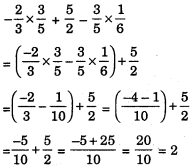
3rd Method
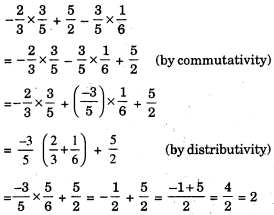
(ii) 1st Method
\(\frac{2}{5} \times\left(\frac{-3}{7}\right)-\frac{1}{6} \times \frac{3}{2}+\frac{1}{14} \times \frac{2}{5}\)
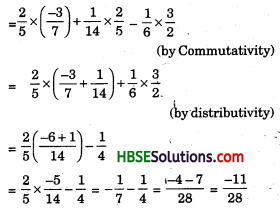
2nd Method
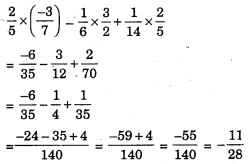
Question 2.
Write the additive inverse of each of the following:
(i) \(\frac{2}{8}\)
(ii) \(\frac{-5}{9}\)
(iii) \(\frac{-6}{5}\)
(iv) \(\frac{2}{-9}\)
(v) \(\frac{19}{-6}\)
Solution:
\(\frac{-2}{8}\) is the additive inverse of \(\frac{2}{8}\) because
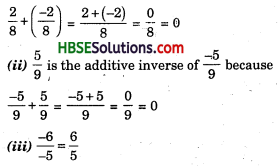
\(\frac{-6}{5}\) is the additive inverse of \(\frac{6}{5}\) because
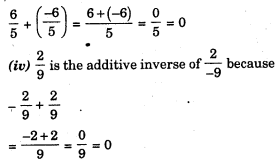
![]()
Question 3.
Verify that – (-x) = x for
(i) x = \(\frac{11}{15}\)
(ii) x = \(-\frac{13}{17}\)
Solution:
(i) We have, x = \(\frac{11}{15}\)
The additive inverse of
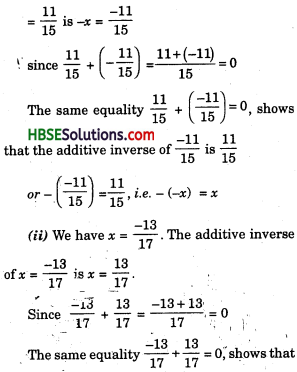

Question 4.
Find the multiplicative inverse of the following :
(i) -13
(ii) \(\frac{-13}{19}\)
(iii) \(\frac{1}{5}\)
(iv) \(\frac{-5}{8} \times \frac{-3}{7}\)
(v) -1 × \(\frac{-2}{5}\)
(vi) -1
Solution:
(i) Let the multiplicative inverse of -13 be x.
∴ -13 × x = 1
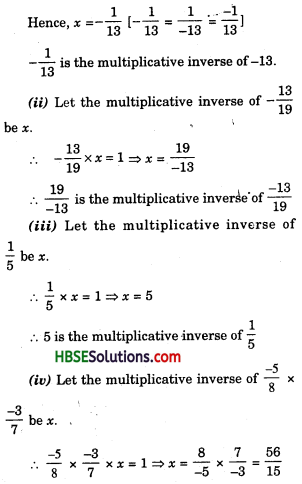
(v) Let the multiplicative inverse of -1 × \(\frac{-2}{5}\) be x.
∴ -1 × \(\frac{-2}{5}\) × x = 1
⇒ x = \(\frac{1 \times 5}{-1 \times(-2)}\) = \(\frac{5}{2}\) or \(\frac{-5}{-2}\)
(vi) The multiplicative inverse of -1 is -1 because -1 × (-1) = 1
![]()
Question 5.
Name the property under multiplication used in each of the following:
(i) \(\frac{-4}{5} \times 1=1 \times \frac{-4}{5}=-\frac{4}{5}\)
(ii) \(-\frac{13}{17} \times \frac{-2}{7}=\frac{-2}{7} \times \frac{-13}{17}\)
(iii) \(\frac{-19}{29} \times \frac{29}{-19}\) = 1
Solution:
(i) 1 is the multiplicative identity. (ii) Commutativity, (iii) Multiplicative inverse.
Question 6.
Multiply \(\frac{6}{13}\) by the reciprocal of \(\frac{-7}{16}\).
Solution:
The reciprocal of \(\frac{-7}{16}\) is \(\frac{16}{-7}\)
The Product of \(\frac{6}{13}\) and \(\frac{16}{-7}\)
= \(\frac{6}{13}\) × \(\frac{16}{-7}\) = \(\frac{96}{-91}\)
![]()
Question 7.
Tell what property allows you to compute \(\frac{1}{3} \times\left(6 \times \frac{4}{3}\right)\) as \(\left(\frac{1}{3} \times 6\right) \times \frac{4}{3}\)
Solution:
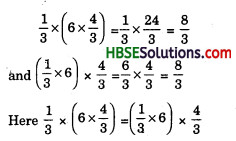
We know for any three rational numbers a, b and c, a × (b × c) = (a × b) × c
The multiplication is associative for rational numbers.
Question 8.
Is \(\frac{8}{9}\) the multiplicative inverse of -1\(\frac{1}{8}\) ? Why or why not?
Solution:
No, the multiplicative inverse of \(\frac{8}{9}\) is \(\frac{9}{8}\) or 1\(\frac{1}{8}\).
Here, -1\(\frac{1}{8}\) is negative. Therefore, \(\frac{8}{9}\) is not multiplicative inverse of -1\(\frac{1}{8}\).
![]()
Question 9.
Is 0.3 the multiplicative inverse of 3\(\frac{1}{3}\) ? Why or why not?
Solution:
0.3 = \(\frac{3}{10}\)
Here, 0.3 × 3\(\frac{1}{3}\) = \(\frac{3}{10}\) × \(\frac{10}{3}\) = 1
We say that a rational number \(\frac{c}{d}\) is called the reciprocal or multiplicative inverse of another a rational number \(\frac{a}{b}\) if \(\frac{a}{b}\) × \(\frac{c}{d}\) = 1
∴ The result will be yes.
Question 10.
Write :
(i) The rational number that does not have a reciprocal.
Solution:
Zero has no reciprocal.
(ii) The rational numbers that are equal to their reciprocals.
Solution:
1 is equal to its reciprocal, because the reciprical of 1 is 1.
-1 is also equal to its reciprocal because the reciprocal of-1 is -1.
-1 × (-1) = 1
(iii) The Rational number that is equal to its negative.
Solution:
Its value negative.
![]()
Question 11.
Fill in the blanks :
(i) Zero has ……………. reciprocal.
(ii) The numbers …………….. and ……………. are their own reciprocals.
(iii) The reciprocal of -5 is …………
(iv) Reciprocal of \(\frac{1}{x}\), where x ≠ 0 is …………
(v) The product of two rational number is always a ……………..
(vi) The reciprocal of a positive rational number is ………………
Answer:
(i) no
(ii) 1.1
(iii) \(\frac{1}{-5}\)
(iv) x
(v) rational number
(vi) positive